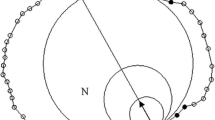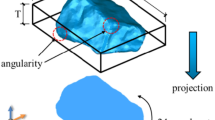Abstract
Concrete is a heterogeneous, multiphase, composite material, and the size and shape of the coarse aggregate used have an important influence on the rheological properties of the concrete. The aggregate is usually simulated with spherical particles in the discrete element method (DEM). However, the shape of real aggregates is uncontrolled and polytropic. Therefore, spherical particles hardly reflect the actual situation. To comprehensively analyze the rheological characteristics of self-compacting concrete (SCC), experimental and simulated tests of slump-flow and L-box tests of different performative SCC are investigated. An efficient and fast random polyhedron particle generation method is proposed to simulate the real shape of the coarse aggregate, which is close to the actual state. The slump-flow and L-box tests of SCC are simulated by using the established discrete element model and the irregular generating particle method. The slump-flow test shows that the generation method could effectively simulate the flow state of concrete, and the L-box test evaluates the passing ability of SCC. The rheological characteristics of the yield stress τ0 and plastic viscosity η are verified as Bingham model parameters, and the numerical results are perfectly consistent with the experimental results.
















Similar content being viewed by others
References
Badry F, Kulasegaram S, Karihaloo BL (2014) Estimation of the yield stress and distribution of large aggregates from slump flow test of self-compacting concrete mixes using smooth particle hydrodynamics simulation. J Sustain Cem Based Mater 5(3):117–134
Berzins M, Kirby RM (2008) Examination and analysis of implementation choices within the material point method (MPM). Cmes Comp Model Eng 31(2):107–127
Chen SG, Sun QC, Feng J, Liu JG (2014) Simulations of Bingham plastic flows with the multiple-relaxation-time lattice Boltzmann model. Sci China Phys Mech 57(3):532–540
Chidiac SE, Mahmoodzadeh F (2009) Plastic viscosity of fresh concrete—a critical review of predictions methods. Cem Conc Comp 31(8):535–544
Cui Y, Nouri A, Chan D, Rahmati E (2016) A new approach to DEM simulation of sand production. J Pet Sci Eng 147:56–67
Cui Y, Chan D, Nouri A (2017) Coupling of solid deformation and pore pressure for undrained deformation—a discrete element method approach. Int J Numer Anal Met 41(18):1943–1961
Cui Y, Choi CE, Liu H, Ng CWW (2018) Effects of particle size of mono-disperse granular flows impacting a rigid barrier. Nat Hazards 91(3):1179–1201
Dellino P, Dioguardi F, Doronzo DM, Mele D (2018) The rate of sedimentation from turbulent suspension: an experimental model with application to pyroclastic density currents and discussion on the grain-size dependence of flow runout. Sedimentology
Dhaheer MS, Kulasegaram S, Karihaloo BL (2016) Simulation of self-compacting concrete flow in the J-ring test using smoothed particle hydrodynamics (SPH). Cement Conc Res 89:27–34
Ding W, Xu W (2018) Study on the multiphase fluid-solid interaction in granular materials based on an LBM-DEM coupled method. Powder Technol 335:301–314
Doronzo DM, Martí J, Dellino P, Giordano G, Sulpizio R (2016) Dust storms, volcanic ash hurricanes, and turbidity currents: physical similarities and differences with emphasis on flow temperature. Arab J Geosci 9(4):1–9
European Federation of Specialist Construction Chemicals and Concrete Systems (EFNARC) (2005) The European guidelines for self-compacting concrete—specification, production and use
Ferellec JF, Mcdowell GR (2010) A method to model realistic particle shape and inertia in DEM. Granul Matter 12(5):459–467
Ferraris CF, Larrard FD (1998) Modified slump test to measure rheological parameters of fresh concrete. Cement Concre Aggregates 20(2):241–247
Gu X, Lu L, Qian J (2017) Discrete element modeling of the effect of particle size distribution on the small strain stiffness of granular soils. Particuology 32:21–29
Höhner D, Wirtz S, Scherer V (2012) A numerical study on the influence of particle shape on hopper discharge within the polyhedral and multi-sphere discrete element method. Powder Technol 226(8):16–28
Kurokawa Y (1994) Study on slump test and slump-flow test of fresh concrete. Trans Japan Concrete Institute 16:25–32
Larrard FD, Szitkar JC, Hu C, Joly M (1994) Design of a rheometer for fluid concretes. Int RILEM Workshop Special Concr: WorkabilityMixing 27:201–208
Larrard FD, Ferraris CF, Sedran T (1998) Fresh concrete: a Herschel-Bulkley material. Mater Struct 31(7):494–498
Li YW, Bao L, Zhou **ao J, Gou WC (2015a) Variation in grain size distribution in debris flow. J Mt Sci-engl 12(3):682–688
Li CQ, Xu WJ, Meng QS (2015b) Multi-sphere approximation of real particles for DEM simulation based on a modified greedy heuristic algorithm. Powder Technol 286:478–487
Li Z, Cao G, Tan Y (2016) Prediction of time-dependent flow behaviors of fresh concrete. Constr Build Mater 125:510–519
Liu C, Sun Q, ** F, Zhou GD (2017) A fully coupled hydro-mechanical material point method for saturated dense granular materials. Powder Technol 314(S1):110–120
Lu G, Third JR, Müller CR (2015) Discrete element models for non-spherical particle systems: from theoretical developments to applications. Chem Eng Sci 127:425–465
Ma H, Li Y, Li Y (2016) Random aggregate model for mesoscopic structures and mechanical analysis of fully-graded concrete. Pergamon Press, Inc 177:103–113
Marks B, Valaulta A, Puzrin A, Einav I (2013) Design of protection structures: the role of the grainsize distribution. American Institute of Physics 1542:658–666
Mast CM, Arduino P, Miller GR, Mackenzie-Helnwein P (2014) Avalanche and landslide simulation using the material point method: flow dynamics and force interaction with structures. Comput Geosci 18(5):817–830
Mechtcherine V, Shyshko S (2015) Simulating the behaviour of fresh concrete with the distinct element method—deriving model parameters related to the yield stress. Cement Concrete Comp 55:81–90
Mechtcherine V, Gram A, Krenzer K, Schwabe JH, Shyshko S, Roussel N (2014) Simulation of fresh concrete flow using discrete element method (DEM): theory and applications. Mater Struct 47(4):615–630
Mirghasemi AA, Rothenburg L, Matyas EL (2002) Influence of particle shape on engineering properties of assemblies of two-dimensional polygon-shaped particles. Géotechnique 52(52):209–217
Noor MA, Uomoto T (1999) Three-dimensional discrete element model for fresh concrete. Numer Simul Fresh Concrete IIS J 51(4):25–28
Ohta M, Nakamura T, Yoshida Y, Matsukuma Y (2011) Lattice Boltzmann simulations of viscoplastic fluid flows through complex flow channels. J Non-Newton Fluid 166(7):404–412
Pieralisi R, Aguado A (2016) Discrete element modelling of the fresh state behavior of pervious concrete. Cement Concrete Res 90:6–18
Potyondy DO, Cundall PA (2004) A bonded-particle model for rock. Int J Rock Mech Min 41(8):1329–1364
Pournin L, Weber M, Tsukahara M, Ferrez JA, Ramaioli M, Liebling TM (2005) Three-dimensional distinct element simulation of spherocylinder crystallization. Granul Matter 7(2–3):119–126
Qian Z, Garboczi EJ, Ye G, Schlangen E (2016) Anm: a geometrical model for the composite structure of mortar and concrete using real-shape particles. Mater Struct 49(1–2):149–158
Remond S, Pizette P (2014) A DEM hard-core soft-shell model for the simulation of concrete flow. Cement Concrete Res 58(15):169–178
Roussel N, Coussot P (2005) “Fifty-cent rheometer” for yield stress measurements: from slump to spreading flow. J Rheol 49(3):705–718
Roussel N, Stefani C, Leroy R (2005) From mini-cone test to Abrams cone test: measurement of cement-based materials yield stress using slump tests. Cement Concrete Res 35(5):817–822
Roussel N, Nguyen TLH, Yazoghli O, Coussot P (2009) Passing ability of fresh concrete: a probabilistic approach. Cement Concrete Res 39(3):227–232
Roussel N, Gram A, Cremonesi M, Ferrara L, Krenzer K, Mechtcherine V (2016) Numerical simulations of concrete flow: a benchmark comparison. Cement Concrete Res 79:265–271
Shyshko S, Mechtcherine V (2008) Simulating the workability of fresh concrete. Mater Struct 43:173–181
Shyshko S, Mechtcherine V (2013) Develo** a discrete element model for simulating fresh concrete: experimental investigation and modelling of interactions between discrete aggregate particles with fine mortar between them. Constr Build Mater 47(5):601–615
Sonebi, Grünewald, Walraven (2007) Filling ability and passing ability of self-consolidating concrete. ACI Mater J 104(2):162–170
Stroeven P, He H, Stroeven M (2011) Discrete element modelling approach to assessment of granular properties in concrete. J Zhejiang Univ-Sc A 12(5):335–344
Subramaniam N, Al-Sudairawi M, Al-Dousari A (2015) Probability distribution and extreme value analysis of total suspended particulate matter in Kuwait. Arab J Geosci 8:11329–11344
Taghavi R (2011) Automatic clump generation based on mid-surface. Continuum and Distinct Element Numer Model Geomechs 14:135–141
Tan LI (2011) Approach to generation of random polyhedral aggregate model for concrete. Structural Engineers
Thomas PA, Bray JD (1999) Capturing nonspherical shape of granular media with disk clusters. J Geotech Geoenviron 125(3):169–178
Ting JM, Meachum L, Rowell JD (1995) Effect of particle shape on the strength and deformation mechanisms of ellipse-shaped granular assemblages. Eng Comput 12(2):99–108
Vasilic K, Meng B, Kühne HC, Roussel N (2011) Flow of fresh concrete through steel bars: a porous medium analogy. Cem Conc Res 41(5):496–503
Vasilic K, Schmidt W, Kühne HC, Haamkens F, Mechtcherine V, Roussel N (2016) Flow of fresh concrete through reinforced elements: experimental validation of the porous analogy numerical method. Cem Conc Res 88:1–6
Wang L, Park JY, Fu Y (2007) Representation of real particles for DEM simulation using X-ray tomography. Constr Build Mater 21(2):338–346
Zhang Z, Zhang X, Qiu H, Daddow M (2016) Dynamic characteristics of track-ballast-silty clay with irregular vibration levels generated by high-speed train based on DEM. Constr Build Mater 125:564–573
Zhang Z, Song X, Liu Y, Wu D, Song C (2017) Three-dimensional mesoscale modelling of concrete composites by using random walking algorithm. Compos Sci Technol 149:235–245
Zhang Z, Cui Y, Chan D, Taslagyan K (2018a) DEM simulation of shear vibrational fluidization of granular material. Granul Matter 20. https://doi.org/10.1007/s10035-018-0844-8
Zhang Z, Zhang X, Tang Y, Cui Y (2018b) Discrete element analysis of a cross-river tunnel under random vibration levels induced by trains operating during the flood season. J Zhejiang Univ-Sc A 19(5):346–366
Funding
The project was financially supported by the National Natural Science Foundation of China (NO. 51708433) and the Fundamental Research Funds for the Central Universities (2017-YB-014; WUT: 2017IVB079).
Author information
Authors and Affiliations
Corresponding author
Rights and permissions
About this article
Cite this article
Zhang, X., Li, Z., Zhang, Z. et al. Discrete element analysis of the rheological characteristics of self-compacting concrete with irregularly shaped aggregate. Arab J Geosci 11, 597 (2018). https://doi.org/10.1007/s12517-018-3960-1
Received:
Accepted:
Published:
DOI: https://doi.org/10.1007/s12517-018-3960-1




